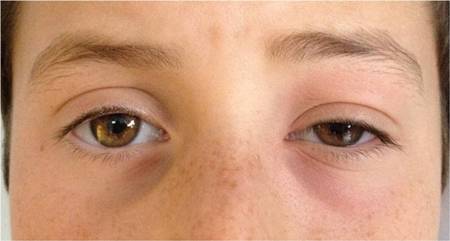Resumo
Definição
História e exame físico
Principais fatores diagnósticos
- presença de fatores de risco
- infecção dos seios nasais recente
- lesão da pálpebra recente
- vermelhidão e inchaço do olho
- dor ocular
- diminuição da visão
- proptose
- edema palpebral
- picada de inseto na pálpebra
- terçol ou calázio
- infecção facial ou da orelha
- oftalmoplegia e diplopia
Outros fatores diagnósticos
- trauma orbitário
- infecção cutânea
- quemose
- sensibilidade ao redor dos olhos
- febre
- eritema da pálpebra
- pressão intraocular elevada
- cefaleia
- mal-estar
- infecção ou tratamento dentário prévio
- fratura orbital
- corpo estranho no olho ou na órbita
- torpor
- náuseas/vômitos
- secreção nasal
Fatores de risco
- sinusite
- idade jovem
- sexo masculino
- vacinação contra a Haemophilus influenzae do tipo b (Hib) ausente em crianças
Investigações diagnósticas
Primeiras investigações a serem solicitadas
- exame clínico
- tomografia computadorizada (TC) do seio nasal e de órbitas com meio de contraste
- contagem leucocitária
Investigações a serem consideradas
- hemocultura
- swab microbiológico (conjuntiva, nasofaringe, feridas externas)
- ressonância nuclear magnética (RNM) do crânio e das órbitas com meio de contraste
- Ultrassonografia orbitária
- punção lombar
Algoritmo de tratamento
celulite periorbitária: organismo causador não identificado
celulite periorbitária: organismo causador identificado
celulite orbitária: organismo causador não identificado
celulite orbitária: organismo causador identificado
Colaboradores
Autores
Sudarshan Srivatsan, MD
Oculoplastics Fellow
Moran Eye Center
University of Utah
Salt Lake City
UT
Declarações
SS declares that he has no competing interests.
Robert Kersten, MD, FACS, FASOPRS
Professor of Clinical Ophthalmology
Division Chief, Oculoplastics
Moran Eye Center
University of Utah
Salt Lake City
UT
Declarações
RK declares that he has no competing interests.
Agradecimentos
Dr Sudarshan Srivatsan and Dr Robert Kersten would like to gratefully acknowledge Dr Sandra Lora Cremers, Dr Sarosh Janjua, and Dr H. Jane Kim, previous contributors to this topic. SLC, SJ and HJK declare that they have no competing interests.
Revisores
David M. Ozog, MD
Director of Cosmetic Dermatology
Department of Dermatology
Cosmetic and Procedural Dermatology
Henry Ford Health System
Detroit
MI
Declarações
DMO declares that he has no competing interests.
I-Hui (Elaine) Wu, MD
Resident
Wilmer Eye Institute
Baltimore
MD
Declarações
IW declares that she has no competing interests.
Cristine Radojicic, MD
Staff Physician
Cleveland Clinic
Cleveland
OH
Declarações
CR declares that she has no competing interests.
Jonathan Smith, MD
Specialist Registrar in Ophthalmology
Royal Victoria Infirmary
Newcastle
UK
Declarações
JS declares that he has no competing interests.
Créditos aos pareceristas
Os tópicos do BMJ Best Practice são constantemente atualizados, seguindo os desenvolvimentos das evidências e das diretrizes. Os pareceristas aqui listados revisaram o conteúdo pelo menos uma vez durante a história do tópico.
Declarações
As afiliações e declarações dos pareceristas referem--se ao momento da revisão.
Referências
Principais artigos
Robinson A, Beech T, McDermott AL, et al. Investigation and management of adult periorbital or orbital cellulitis. J Laryngol Otol. 2007;121:545-7. Resumo
Chandler JR, Langenbrunner DJ, Stevens ER. The pathogenesis of orbital complications in acute sinusitis. Laryngoscope. 1970;80:1414-1428. Resumo
Hamed-Azzam S, AlHashash I, Briscoe D, et al. Common orbital infections ~ state of the art ~ Part I. J Ophthalmic Vis Res. 2018 Apr-Jun;13(2):175-82.Texto completo Resumo
American Academy of Ophthalmology. Orbital cellulitis. Apr 2024 [internet publication].Texto completo
Artigos de referência
Uma lista completa das fontes referenciadas neste tópico está disponível para os usuários com acesso total ao BMJ Best Practice.

Diagnósticos diferenciais
- Pseudotumor orbitário (inflamação orbitária idiopática)
- Doença ocular tireoidiana
- Panoftalmite
Mais Diagnósticos diferenciaisDiretrizes
- Guide to utilization of the microbiology laboratory for diagnosis of infectious diseases: 2024 update by the Infectious Diseases Society of America (IDSA) and the American Society for Microbiology (ASM)
- Appropriateness criteria: orbital imaging and visual loss - child
Mais DiretrizesFolhetos informativos para os pacientes
Celulite e erisipela
Herpes-zóster: o que é?
Mais Folhetos informativos para os pacientesConectar-se ou assinar para acessar todo o BMJ Best Practice
O uso deste conteúdo está sujeito ao nosso aviso legal